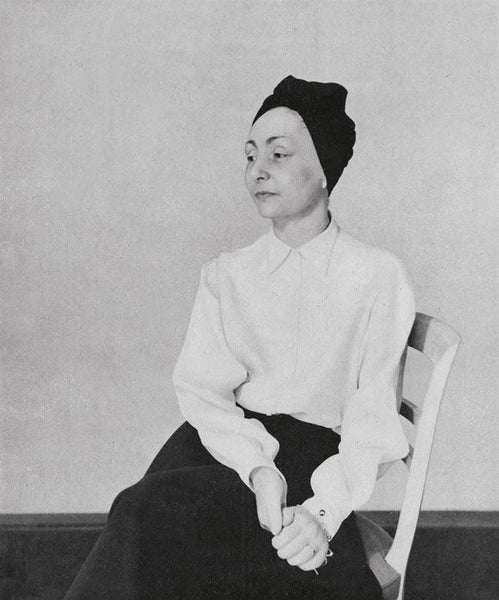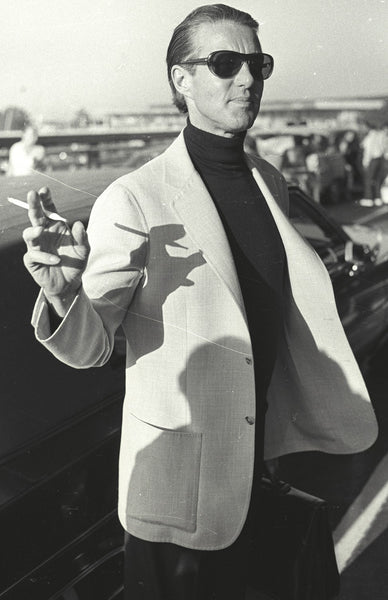Designer Spotlight: Ottavio and Rosita Missoni

Missoni was born of the partnership between husband and wife design duo Ottavio and Rosita Missoni. Ottavio designed and plotted the patterns and colors while Rosita designed the shape and structure of the garments.
Ottavio “Tai” Missoni was born in Dubrovnik in what is now Croatia, in 1921. Tai’s first passion was fitness, his parents, Teresa De Vidovich, countess of Capocesto and Ragosniza, and Vittorio Missoni, a sea captain, recognized his talent and dubbed him “Son of Apollus.” Tai joined the Italian National Track Team in 1937 at the age of 16.
It seems natural for Missoni to be associated with knitwear, seeing as Tai was an avid sportsman throughout his life. His vested interest in sportswear lead the Missonis to create what would become the Italian activewear industry, and by conjunction the Italian ready - to - wear industry.
Rosita Jelmini was born in 1931 in Golasecca, in the province of Varese, to a family of textile industrialists who produced shawls and embroidered residential fabrics. She innovated the knitwear industry by introducing machinery that was used to create house wears and instead using it to make garments.
Ottavio Missoni was an infantryman during World War II and was captured by the British during the battle of El Alamein, later spending the rest of the war in a prisoner-of-war camp.
After the war Ottavio went on to compete for Italy in the 1948 London - held Olympics. Missoni’s first brush with fashion was when he and his teammate Giorgio Oberweger briefly launched a fashion line focused on wool tracksuits. The tracksuits, which they called Venjulia suits, were wildly successful, leading to their use by the Italian olympic team.
Ottavio and Rosita met in London during the olympics. The couple settled in Gallarate where they opened an atelier. The couple experimented with the weight and construction of textiles, using the machines Rosita’s family used to create fabrics for house wears. In 1958 Missoni supplied their first garments - a series of bright, striped, casual shirt dresses- to various department stores in Milan.
In 1965 Missoni burst onto the world stage with the release of a collaborative collection with Emmanuelle Khahn, who Rosita had met and befriended in New York. A year after the collection, Missoni had their first runway show at the Palazzo Pitti. The show was a controversial success, with much publicity garnered by the knits which were accidentally revealed to be sheer when under stage lights. Missoni was soon featured in Vogue, Marie Claire, Women’s Wear Daily, Elle, and Harper’s Bazaar. Despite the success of the show, the Missoni’s were not invited back to Florence. Fortunately, the wider world of fashion found it innovative, influential editors like Anna Piaggi (who had written about Missoni earlier that year), Consuelo Crespi, and Diana Vreeland championed Missoni.
Missoni continue to develop. They opened their first stateside boutique at Bloomingdale's in New York in 1970, and six years later, in 1976, they opened their first self-owned boutique in Milan. To celebrate Missoni’s 25th anniversary, Milan’s Rotonda della Besana was host to a retrospective that later made its way New York’s Whitney Museum. The Missoni exhibition was the first fashion exhibit ever held by the Whitney.
In 1993 Tai was honored by the Italian government and dubbed a “Cavaliere al Merito del Lavoro” for his contribution to Italy’s fashion industry and Missoni’s hand in the development of Milan as a fashion capital.
In 1997 The Missoni’s took a step back and passed the reins of the business to their children, making Missoni one of the few tightly knit family businesses in fashion. Their sons, Vittorio and Luca, handled the financial end, while their daughter, Angela, was made creative director of the company. Tai and Rosita remained involved, with Rosita heading the Missoni Home line.
Tai passed away in 2013 after struggling with cardiac issues perhaps connected to his son, Vittorio’s, disappearance off the coast of Venezuela earlier that year. Rosita has continued to act as matriarch of Missoni; she was awarded “Cavaliere al Merito del Lavoro” by the Italian Government in 2014.
Rosita and Tai helped put Italian fashion on the map. Their combination of slinky sensual forms and brilliant zigzag and watercolor space dye patterns (often influenced by Guatemalan, Aztec, and Incan designs, as well as Art Deco, Impressionism, and abstract art) defined Italian mid century fashion, while still being harmonious enough to prevail throughout the decades as a mainstay of luxury style.
Also in Adore MRS. Couture

Designer Spotlight: Madame Gres

Designer Spotlight: Roy Halston Frowick
Halston was thrown into the limelight when Jacqueline Kennedy wore his pillbox hat to John F. Kennedy’s inauguration. Soon Halston expanded into women’s wear, creating both couture and ready-to-wear fashion catering to the fashionable and elite jet set. Halston also accepted the honor of designing the 1976 US Olympic team uniforms, redesigned Braniff Airlines’ uniforms in 1977, and created uniforms for the New York Police Department and the Girl Scouts in 1978.
Halston was innovative, using slinky knit material and ultrasuedes, and introducing a halter dress design that elongated a wearer’s silhouette. He pioneered the sensual and soft draped looks associated with disco and his beloved Studio 54.

